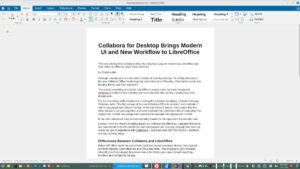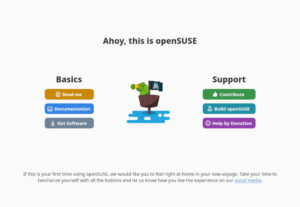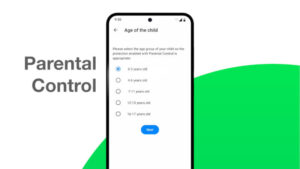 Mark Shuttleworth can’t leave well enough alone. First it was Unity. Then it was Wayland. Now it’s Mir. Inquiring minds want to know: what does he think he’s trying to do? It’s simple, really. He’s not trying to do anything. All indications are that he’s actually accomplishing what he’s setting out to do. Except for making money and only time will tell if that’s going to work out for him.
Mark Shuttleworth can’t leave well enough alone. First it was Unity. Then it was Wayland. Now it’s Mir. Inquiring minds want to know: what does he think he’s trying to do? It’s simple, really. He’s not trying to do anything. All indications are that he’s actually accomplishing what he’s setting out to do. Except for making money and only time will tell if that’s going to work out for him.
Unity was a no-brainer. Practically everybody hated GNOME 3, so he pretty much had to do something. What everyone expected that something to be was along the lines of Cinnamon or MATE, an interface that would offer users the look and feel of GNOME as they knew it, not as it had become. What Shuttleworth offered was, in the words of Monty Python, “something completely different.” Different from both GNOME 2 or 3. Different from KDE. Different from Windoze and OS X. Unique to Ubuntu.
I’ve never used Unity. I’m not a Ubuntu (or GNOME) user. But when I look at Unity, I don’t see what all the fuss is about. It looks usable. Certainly, it’s polished. By all reports, it works well and is as bug free as anything out there. I understand why people don’t like GNOME 3. I don’t much like what I see when I look at screen shots of it either. But to my eyes, Unity looks to be perfectly usable. But a lot of users don’t like it and they’ve moved over to other distros, mainly to Mint.
It turns out that perhaps Shuttleworth has been playing his cards close to his chest and that he maybe had a plan for Unity all along. It started off as a shell designed to make more efficient use off the smaller screen sizes of netbooks (remember them?). Then two years ago, it became the default GUI for the Ubuntu desktop, evidently because he was unable to get the devs at GNOME to play ball with him and redesign the GNOME shell into something people wanted.
So why did he choose Unity, a GUI designed for smaller screens, to throw up on the ever larger and wider screens of the desktop? Maybe because he was wearing some kind of visionary hat, which told him the direction Ubuntu needs to go in order to survive and become profitable?
Oh yes, profits–that dirty nasty word. Remember, Ubuntu is not a community distribution. It’s an operating system released by a commercial enterprise, as pointed out Friday by LinuxBSDos.com:
“…Ubuntu is a suite of operating systems…sponsored by a company called Canonical Ltd. And Canonical is a commercial entity with employees, paid employees. As such, any decision taken by its management is taken with the commercial interest of the company front and center.
“And that’s where it begins and ends. Commercial interest(s). Even though Canonical has been in business since early 2004, the company is not profitable. Keep that in mind, because that’s the driving force behind almost every decision and project coming from the mind of Mark Shuttleworth and crew. The need to be profitable.”
If five thousand people were to read this article on a browser running atop Ubuntu, I’ll bet dollars to doughnuts that those five thousand instances of Ubuntu resulted in less than a hundred American greenbacks (or the currency of your choice) flowing into Canonical’s coffers.
It cost a lot to run a commercial software company–even if you’re doing it on the cheap by stringing together already existing code. Shuttleworth’s been rolling his own software, meaning he hasn’t been doing it entirely on the cheap. All indications are that his efforts to keep Canonical afloat are costing somewhere around $30 million a year. Agreed, Mark Shuttleworth has a lot of money–but not an endless supply.
| [yop_poll id=”4″] |
Sun Microsystems is a good example of what happens to a company sitting on a huge pile of money when they can’t figure-out a way to turn red ink into black. After the dot-com bubble burst, Sun was able to live off their savings for about a decade before being forced to agree to become Oracle’s bride. It’s doubtful that Shuttleworth would be able to find such a suitor for Canonical as his company’s major assets are programs written under a copyleft license.
Shuttleworth’s visionary hat might’ve told him there was still a buck to be made in mobile; that what was missing was a unified mobile experience that seamlessly spans from smartphone to tablet to desktop and laptop. Unity would be a perfect interface for that and Ubuntu Linux would be more than a suitable OS.
Microsoft had the same vision, of course, but Unity would work much better than the GUI formally known as Metro, because it works well in both a desktop and mobile environment. It could be configured to be ascetically pleasing in both point and click as well as touch and swipe environments.
Which moves us to the X.org, Wayland, Mir display server brouhaha.
In 2010, Shuttleworth announced that Ubuntu would be moving from the old Linux standby of X for the simpler and more efficient Wayland display server. For a variety of technical reasons a replacement for X would be good for desktop Linux. However, not surprising for an open source project, development of Wayland has proceeded at a snail’s pace, as observed by Michael Larabel on Phoronix last November:
“The plans back in November of 2010 were for Ubuntu’s Unity desktop to eventually run on Wayland rather than the long-standing X.Org/X11 Server. Mark acknowledged back then that it would likely be a gradual transition and it still will be the case. Wayland 1.0 was recently released, but it’s still not ready to take on the world with missing features, not all drivers/hardware being Wayland-compatible, and other shortcomings.”
For two years Canonical stood behind their plans to eventually move Ubuntu to Wayland, despite the fact that development wasn’t happening quickly on the project. Then, in February we heard from Ubuntu Community Manager Jono Bacon that the plans to move to Wayland were “under review.” Last week we learned that Canonical had scraped all Wayland plans and that a new display server, called Mir, would be developed in house.
Again, inquiring minds asked why?
The move to a better display manager than X11 for desktop Linux would be a nice improvement, but not something that has to be done. However, moving away from X will be absolutely necessary before introducing GNU/Linux to the smartphone market for a variety of reasons.
So what was wrong with Wayland? Why reinvent the wheel when the wheel is already being reinvented? The reason isn’t entirely technical, as Shuttleworth would have you believe. The reason has more to do with logistics–Ubuntu needs this sooner rather than later–and the need to separate Ubuntu from the crowd of other Linux distros.
All of this was pointed out by Sam Varghese on iTWire on Thursday:
“Shuttleworth tried to get other distributions to agree to an uniform release schedule but failed; he tried to get the GNOME project to take up some of his objectives but failed again. Given that the main developers for Wayland are unlikely to yield to any requests he makes, he has decided that the best thing to do is to strike out on his own. …
“Mir also gives Ubuntu another point of difference, another selling point. Shuttleworth wants to make Ubuntu the one GNU/Linux distribution that can be used across all platforms with the user not having to re-learn a great deal. This is not dissimilar to the goals that other companies have.”
It’s do or die time for Shuttleworth and Canonical. If he can come up with an OS that works seamlessly from phone to desktop, he still has time to enter the mobile market and make a mark. But this window of opportunity (excuse please) won’t be open forever. He must make his move and he must do so quickly.
Which begs another question from inquiring minds. Will the slew of distros that are based on Ubuntu also adopt Mir? On Wednesday, Dean Howell at The Powerbase put this question to Aaron Seigo, a Plasma developer at KDE, specifically as it relates to Kubuntu:
“I would honestly expect Kubuntu and other *buntu derivatives to continue using x.org and eventually move to Wayland. This is because they are more likely to work with their upstreams, who are either staying on X11 or working on Wayland migrations, rather than jump to the Mir Unity shell.
“Where it will get uncomfortable is that these derivatives will likely end up having to maintain X.org, Wayland, etc on their platforms and will no longer be able to rely on Canonical for this. This is likely to push the derivatives closer to each other and further from Canonical. Perhaps we’ll even see some simply rebase on Debian itself.”
This would appear to be a pretty good analysis. Indeed, Linux Mint founder and project leader Clement Lefebvre told Swapnil Bhartiya in an interview published Friday on Muktware:
“Mir is irrelevant. Nobody ever heard of it a week ago and plans don’t change based on wild speculations. If Ubuntu isn’t clear on what they want Ubuntu to be, that’s their problem. It has nothing to do with Linux Mint.”
This would seem to indicate that the most successful Ubuntu based distro isn’t ready to drop X for Mir, but only time will tell. The implementation of Mir into Ubuntu is at least a year away and like Wayland, Mir will still make X available to laptop and desktop users through an on-demand rootless X server, similar to what Wayland has planned.
Christine Hall has been a journalist since 1971. In 2001, she began writing a weekly consumer computer column and started covering Linux and FOSS in 2002 after making the switch to GNU/Linux. Follow her on Twitter: @BrideOfLinux







Unity was the reason I switched to xubuntu two years ago. Just did not like it. It might be all right on a tablet though, aesthetically speaking … but hell, I want a desktop that looks like a freaking desktop. And just works.
This piece you just wrote, has to be *the* single article, describing the current situation, without being too geeky and too (anti)Ubuntu and keeping a cool head while assessing the situation.
Its all there, written CLEARLY. You just have to be open minded enough to read it in an eyes open mode.
While being in the process of ditching ubuntu (switched to Xubuntu and seeking to switch again outside the *buntu ecosystem), I certainly can NOT blame them, for trying to make a profit.
The funny thing is that if Canonical DO make it, in the tablet/smartphone world, there is no point talking about Gnome3 or Wayland and their respective developing cycles anymore. They will be obsolete. But that is something for *their* leadership to deal with, and not us (as in the users).
Unity is not the only reason that I left. It is only one of a list of reasons:
Amazon
Banshee
Beagle
Gnome 3
Mir
Mono
Moonlight
Zeitgeist
Ubuntu One
UEFI – http://www.youtube.com/watch?v=2m8ABmlrv5k
Unity
Although I really appreciate Cannonical’s contributions to Linux, Ubuntu 10.4 had two things that are missing today: stability and privacy. I moved to Mint Mate as a result.
I agree with your assessment that Canonical needs to become profitable to keep pushing Ubuntu. I also do not mind Canonical trying to make ubuntu unique. They are a company and must act like one, incl. working on something and introducing it into the market with a splash.
What I found disturbing is about the mir announcement was that I went away with the feeling that wayland was being badmouthed. I had expected better behavior from a company that claims to value “community” and that started out tooting about its ethics: Canonical fell short of the image they keep projecting about themselves here.
You argue that canonical is frustrated with the progress wayland was making and needed to have the component done for their own plans to proceed. I agree that they had to act, but rewriting a critical component from scratch is not faster than adapting an existing one. Maybe putting some resources into wayland after announcing the grand masterplan two years ago would have helped? Announcing plans does not get any work done after all.
That the developers assigned to the project do not have understood the competition deeply enough to provide reasons for starting that rewrite does not bode well for the finished product.
My opinion is that canonical is alienating people they need later for no good reason, mostly due to poor planing and management:
* Canonical needs developers to become a contender in the TV/phone/desktop market. Linux developers are the most knowledgeable group here… and the most likely to write applications for ubuntu phone. Alienating is not a smart move.
* Canonical needs the ubuntu community to keep the desktop side strong. The cross-device proposal they are trying to sell is not going to work otherwise. Again alienating the free software community is not a smart move.
* Any company has limited resources and needs to make best use of it. So it makes sense to concentrate them on the areas where they can distinguish themselves from the competition. I doubt that a display manager that is hardly user-visible is the right place for that. No user is ever going to buy a phone because it runs mir instead of wayland.